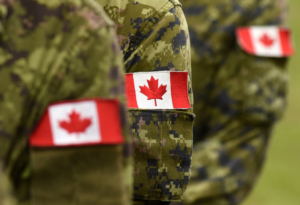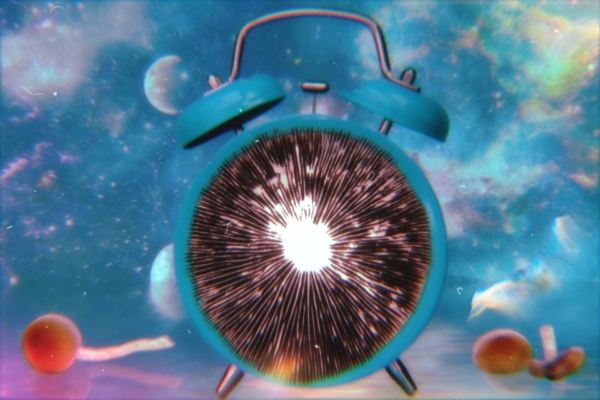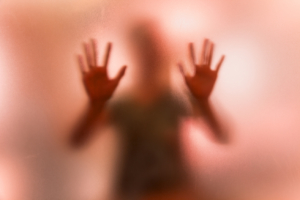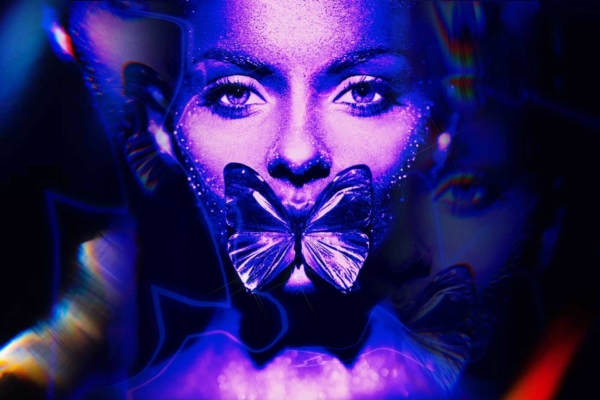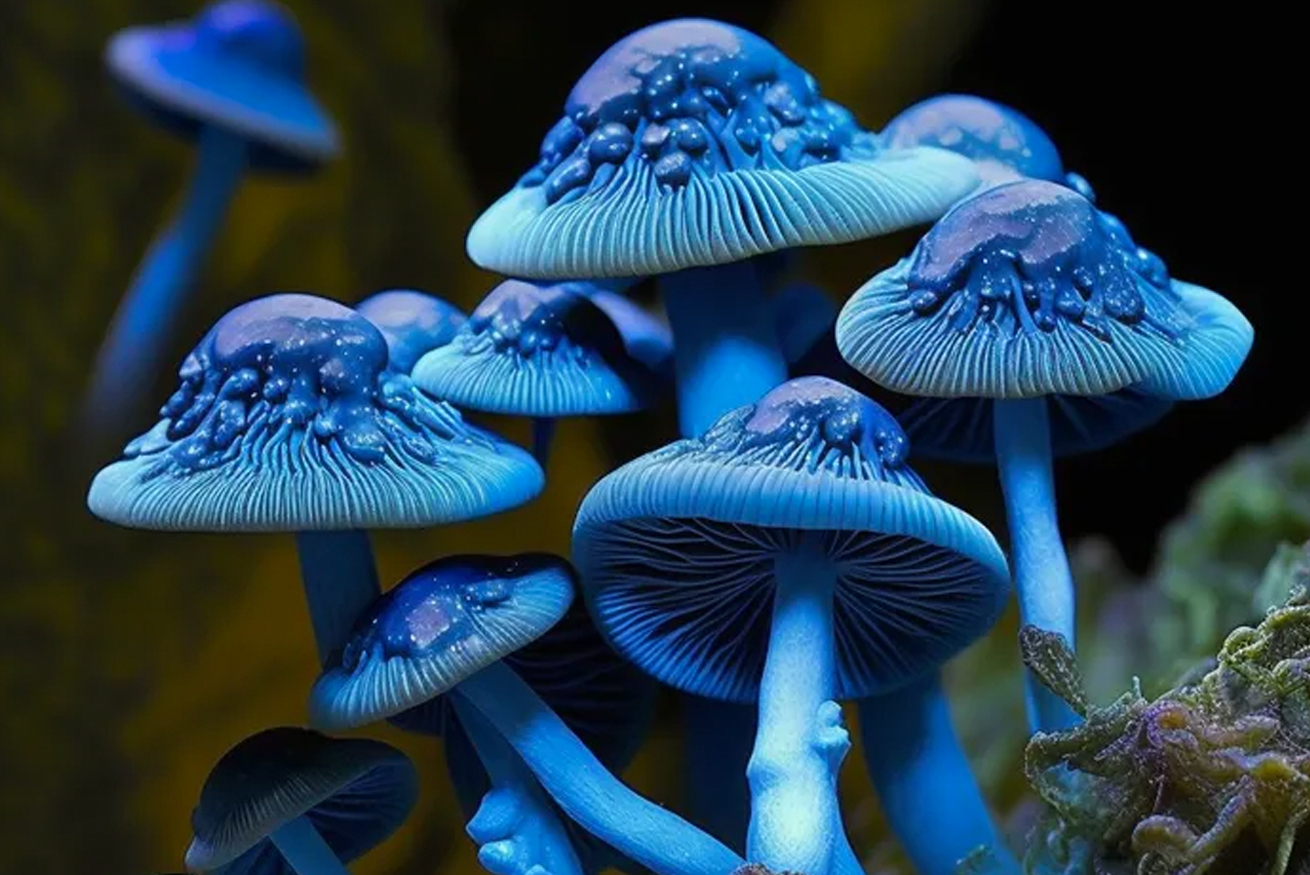
In the vast world of psychedelic mushrooms, Blue Meanies stand out as a potent and revered strain. Known for their potent visual and auditory effects, Blue Meanies have captured the interest of psychonauts seeking profound and transformative experiences. In this comprehensive guide, we delve into the origins, characteristics, effects, dosage, and safety considerations of Blue Meanies, providing valuable insights for those curious about exploring this unique mushroom strain.
What Are Blue Meanies?
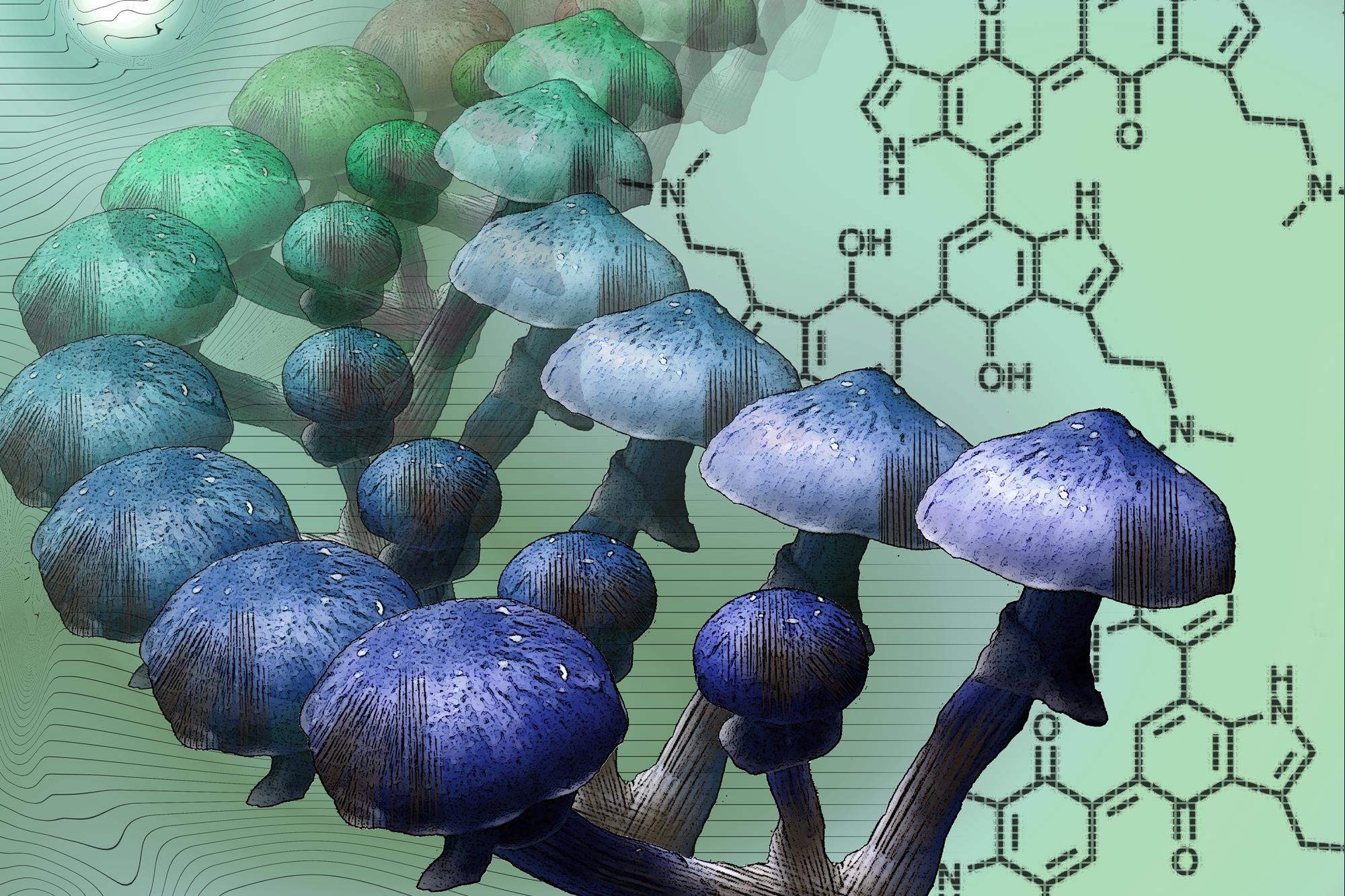
Blue Meanies, scientifically known as Panaeolus cyanescens, are a subspecies of magic mushrooms that belong to the Bolbitiaceae family and Panaeolus genus that are thought to have originated in Asia. Blue Meanie mushrooms distinguish themselves from the well-known Psilocybe genus, while still containing the sought-after psilocin compound. With psychoactive content 2-3 times stronger than many other strains, Blue Meanies are renowned for their potent effects and vibrant hues.
Read also: The Strongest Magic Mushroom Species Ranked by Potency
Supposedly, Blue Meanies were named after the main antagonists of The Beatles’ 1968 animated film Yellow Submarine, but it is unsure if this is simply just a rumor. Yet, there exists some confusion surrounding their colorful name with Blue Meanies racking up a wide array of different names. So many names exist for this one mushroom, that it has become confusing knowing what to call it.
Their scientific name originates from the Greek genus “Panaeolus,” describing the mushroom’s texture, and the Latin species “cyanescens,” representing its characteristic dark blue coloration when bruised. Some people know Blue Meanies as another scientific name though: Copelandia cyanescenes, which is a synonym to their more widely accepted Panaeolus descriptor. To make things even more confusing, there is a Psilocybe mushroom named Psilocybe cyanescens, but the two are very different mushrooms that grow in completely different environments. It is important to know exactly which Blue Meanie mushrooms you are referring to, and if buying, being aware that different names for the same mushroom exist.
What Do Blue Meanies look like?

Blue Meanies mushrooms have specific characteristics that aid in their identification. They typically have caps (pileus) that are light brown in early growth that then fade to a grayish white at full development with yellow-brown tones found, too. The caps have a diameter of approximately 0.5 to two centimeters. Initially, they are hemispheric and later expand to a bell-shaped (campanulate) or convex shape. When young, the cap margin is incurved. As they dry out, the caps become slightly hygrophanous, losing their color and often developing cracks in dry weather. Depending on the weather, if too dry, the caps may crack and bruise blue.
They typically have slim, elongated stems with a conical cap covered that expands and flattens with maturity. Their gills are broad, tight, semi-attached to the stem, and have a speckled, cloudy appearance. The gills of Panaeolus cyanescens are attached to the stem in a broadly adnate to adnexed manner. Adnate attachment means the gills are mostly attached, while adnexed attachment means they are only slightly attached. These gills are close, black or grey in color, and exhibit a spotty, speckled, or cloudy appearance. This appearance is caused by the spores ripening together in tiny patches on the gill surface. The different patches darken at different times, resulting in a mottled appearance. As the spores mature, the gills turn black. It is worth noting that all species, except for Panaeolus foenisecii, produce a jet black spore print.
However, the most prominent identifying feature is their intense blue bruising reaction, which occurs when the mushrooms are handled or damaged. It is not uncommon for their caps to be bruised. While it is important to mention that this bruising reaction happens to all psilocybin-containing mushrooms, the caps often don’t bruise as much as they do in Blue Meanies.
Where Do Blue Meanies Mushrooms Grow?
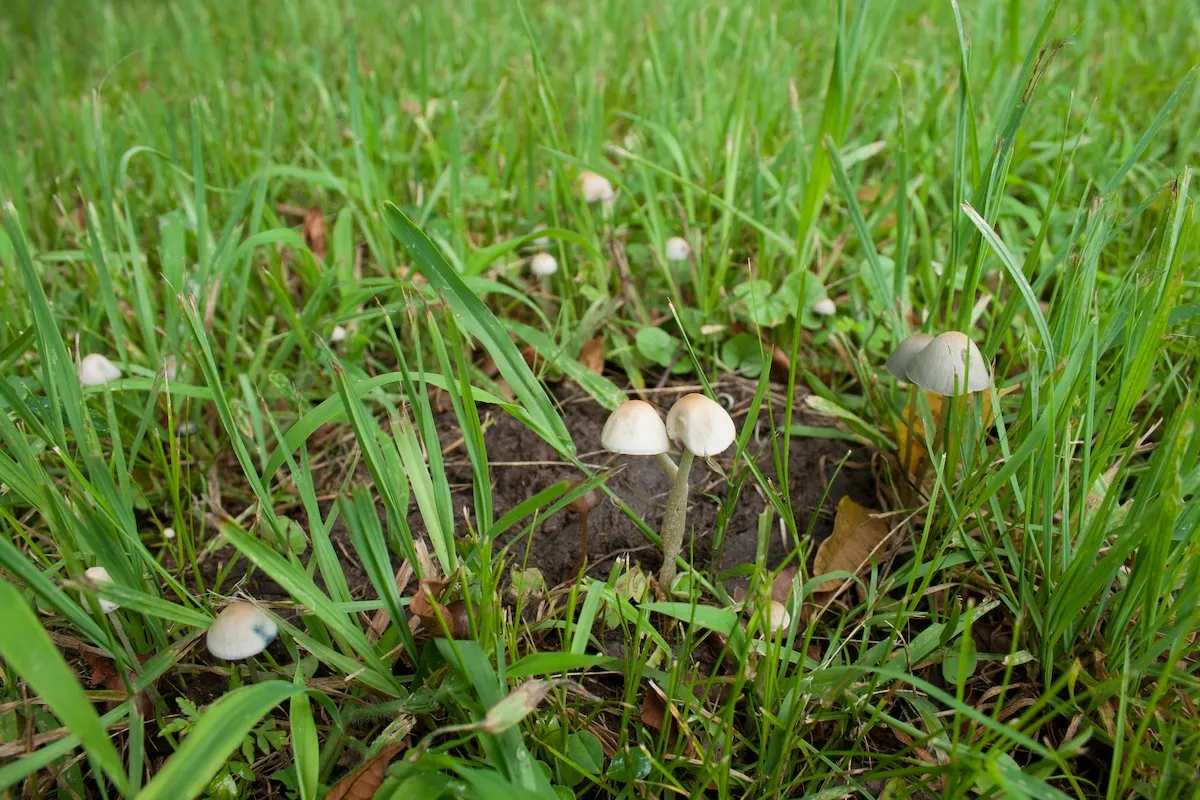
Blue Meanies (Panaeolus cyanescens) are found in various regions around the world. These mushrooms thrive in tropical and subtropical climates, where they can be commonly found in specific environments such as fertilized grasslands and decomposing organic matter like dung. During the damp and humid periods of summer, Blue Meanies emerge in regions with moderate climates, showcasing their unique beauty.
Blue Meanies are not limited to a single location. They have been reported to grow in countries like Australia, Hawaii, Southeast Asia, and parts of Central and South America. In fact, these captivating mushrooms can be found in many corners of the globe, including Mexico, South America (Colombia, Bolivia, Brazil, and Peru), Eastern Australia, India, Bali, Southeast Asia, South Africa, France, and Italy.
In tropical regions, Blue Meanies can be observed growing year-round. However, in subtropical climates, those interested in foraging for Panaeolus cyanescens will have a better chance from late spring to autumn. Blue Meanies are commonly found growing singly or in clusters on cattle or horse dung in pastures and fields. They tend to emerge during the spring or rainy seasons.
In the United States, Blue Meanies thrive from Florida along the Gulf Coast, where they fruit almost year-round on “cow pies.” It is believed that they have spread to other countries through the movement of livestock. It is assumed that Panaeolus cyanescens was introduced to the Hawaiian islands in the early 1800s when cattle were imported from the Philippines. Presently, they can be found in tropical and subtropical regions of both the Northern and Southern Hemispheres.
Read also: 12 Things to Know Before You Buy Psilocybin Spores
What Is the Potency of Blue Meanies Mushrooms?
Blue Meanies mushrooms are renowned for their high potency. They contain significant amounts of psilocybin and psilocin, making them one of the strongest psychedelic mushroom strains. The exact potency can vary based on growing conditions, genetics, and other factors, but it is generally advisable to approach Blue Meanies mushrooms with caution and start with lower doses. Laussman & Sigrid Meier-Giebing reported in 2010 the presence of psilocybin at 2.5% and psilocin at 1.2% in Blue Meanies.
However, when it comes to quantifying the potency of psilocybin mushrooms, the Psilocybin Cup hosted by Oakland Hyphae is also referenced quite often. So far, four samples of Blue Meanie mushrooms have been tested in this competition. Based on the results, the average levels of psilocybin and psilocin in the Blue Meanie strain are 0.67% and 0.05% respectively, measured as a percentage of the dried weight. The average total tryptamine content is around 0.75%, with the highest recorded sample registering at 0.87%. It is important to note that potency can vary significantly depending on the conditions in which the mushrooms are grown and stored. The aforementioned results were obtained from samples cultivated by expert growers.
In comparison, the popular Psilocybe cubensis mushroom has psilocybin and psilocin content in the range of 0.13%-0.42%, making Blue Meanies significantly more potent. Other researchers have also found a significant presence of serotonin, urea, and baeocystin, the latter which has been thought to be psychoactive as well.
What Is a Blue Meanies Trip like?
Just like with a psilocybin mushroom, you can expect to experience perceptual changes, synesthesia, emotional shifts, and a distorted sense of time. Perceptual changes can include visuals such as halos around lights and objects as well as geometric patterns when your eyes are closed. You may also experience vivid colors, tracers, distorted vision, and a sense of the world breathing around you.
Thoughts and emotions can change, too. It’s not uncommon to have a sense of openness to thoughts and feelings that you avoid in your everyday life, as well as a sense of wonder and delight with the world around you, the people in your life, and your own mind. You may also feel a sense of peace and connection with the world.
Strong emotions, both enjoyable and challenging, are common during a journey. When undesirable feelings do arise, it’s best not to resist but rather let the feelings run their course. Many people who have reported the presence of strong negative emotions also report feeling a simultaneous sense of calm acceptance and detachment, especially if they don’t resist and remind themselves that the emotions are temporary. Resisting the emotions can lead to a “bad trip.”
Always ensure you have a proper set and setting before tripping, as this is one of the most important steps for having an enjoyable experience. Do not trip if undergoing high amounts of stress or mental anguish, and be in a safe, supportive environment, preferably with an experienced trip sitter.
Blue Meanies Psychedelic Effects
When consumed, Blue Meanies induce a range of effects that can vary from person to person. Common experiences include:
- intense visual distortions
- vibrant colors
- heightened sensory perception
- altered sense of time
- euphoria
- spiritual insights
Users may also experience emotional shifts, introspective thoughts, and a sense of interconnectedness with the universe.
Are There Any Side Effects?
While Blue Meanies mushrooms can provide transformative experiences, it is crucial to be aware of potential side effects.
These may include:
- nausea
- stomach discomfort
- increased heart rate
- anxiety
- confusion
- temporary changes in mood.
It is important to note that the intensity and likelihood of side effects can vary depending on the individual, dosage, set and setting, and other factors. It is advisable to approach Blue Meanies mushrooms with proper preparation, responsible use, and consideration for personal health and safety.
Some Blue Meanies Dosage Recommendations?

Due to their potency, it is crucial to approach Blue Meanies with caution and carefully consider dosage. It is highly recommended to start with a low dose with these mushrooms and work up to stronger doses. The recommended dosage for beginners is typically around 1 to 1.5 grams of dried Blue Meanies. Intermediate users may opt for 2 grams, while experienced users may venture into 3.5g and higher doses. Again, it is important to start with lower doses and gradually increase as tolerance and familiarity with the effects develop.
How to Grow Blue Meanies Mushrooms:
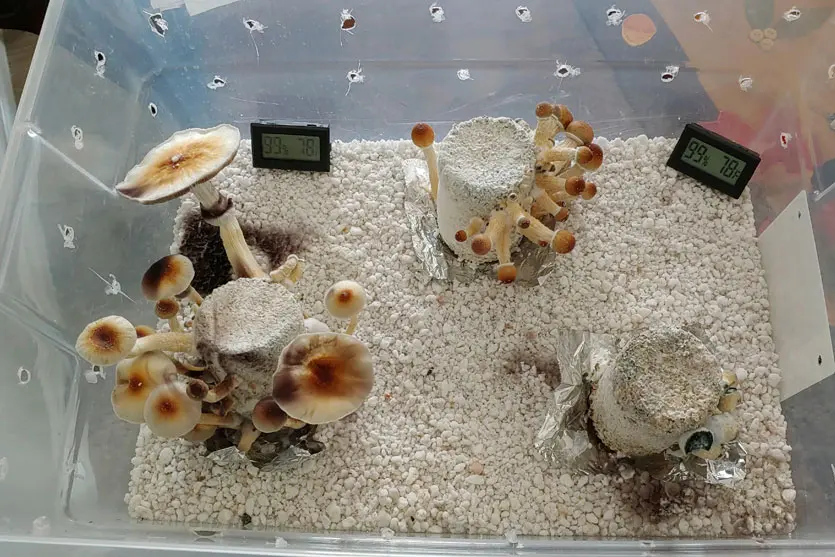
Growing Blue Meanie mushrooms can be slightly harder than their Psilocybe cubensis counterparts, but it is nothing proper planning and a good setup can’t help facilitate. Panaeolus cyanescens mushrooms have a slower growth rate compared to cubensis. They typically take twice as long to form pins after exposing the mycelium to fruiting conditions. However, the longer cultivation time increases the risk of contamination. Therefore, maintaining cleanliness is crucial when cultivating these specific mushrooms. Additionally, having prior experience with using casing layers is highly recommended. Blue Meanies love moisture, so the growing chamber should always have high moisture levels. Use a hygrometer to get an accurate reading of the moisture in the growing environment — adequate levels should be above 75%.
Using a “Martha” grow room can be a good way of ensuring the adequate moisture levels and fresh air exchange that these mushrooms require, but it does take up some space, so it may not be recommended for those with space constraints. Use a casing layer of a moisture-retaining material such as vermiculite to ensure your mushrooms and substrate are always well moisturized.
The most important thing to be aware of when growing Blue Meanies mushrooms is to ensure the correct spores have been procured from a reputable seller. Check out our guide on growing mushrooms for a full list of detailed steps to do it at home!
Identifying Blue Meanies Look-alikes
Despite their popularity, identifying Blue Meanies from their look-alikes can be challenging for amateurs and even trained professionals. Let’s explore some of the common Panaeolus cyanescens look-alikes, which include Panaeolus antillarum and Pholiotina rugosa. For instance, the main differentiator between Panaeolus antillarum and Blue Meanies is their cap color and appearance and their spore print color. Panaeolus antillarum has light brown to tan caps that flatten as they mature, while Blue Meanies have dark brown to almost black caps. Panaeolus antillarum has a dark brown to black spore print, whereas Blue Meanies produce a dark purple-brown spore print. Tubaria furfuracea is also similar to Blue Meanies mushrooms but grows in wood chips instead of dung. It has a hygrophanous cap like Panaeolus cyanescens but fades in color. Psathyrella can also be mistaken for Panaeolus; this species often grows on wood or lignin-enriched soils and has a brittle stem. When foraging, it’s important to have a field guide and online resources for identification. Remember to seek permission from landowners and be aware that possessing psilocybin-containing mushrooms is illegal in most places.
Final Thoughts:
Blue Meanies mushrooms offer a profound and intense psychedelic experience for those seeking personal growth, spiritual insigh
Microdosing, the practice of taking small doses of psychedelics, is gaining popularity in the zeitgeist. A 2023 study published in the journal of Nordic Studies on Alcohol and Drugs Online, reported that microdosing could make you feel more authentic. The results showed that participants saw significantly higher levels of state authenticity on the day they microdosed and the day after compared to other days. The effect was 1.7 times stronger on the microdosing day, suggesting that microdosing could make you feel more authentic. Another 2021 study, published in Scientific Reports, evaluating the microdosing practices, motivations, and mental health of self-selected microdosers and non-microdosers, showed that microdosers were less likely to use alcohol and were most likely to abstain from consuming alcohol entirely. Similarly, microdosers were also more likely to refrain from using nicotine, with more than 25% of participants saying reducing their use of this substance was a motive for microdosing. While more research is needed to provide validity to anecdotal reports of psilonauts, one thing is for sure – the practice of microdosing is trending.
While many opt to use the common Psilocybe cubensis mushroom to do so, it is not the only mushroom (or substance) that can be used. Microdosing with Blue Meanies is possible just as long as proper planning has been done.
The most important thing when microdosing Blue Meanies will be finding the right dose. Because these mushrooms are more potent than the average shroom, it is important to find one’s optimal dose. Always start low, and because of their potency, start lower than the recommended 0.10g microdse starting dose. Increase the dose by 0.1-0.3g every dosing day until subtle effects are felt, such as drowsiness or increased awareness. Then that dose must be brought down by 0.1-0.2g in order to find one’s optimal dose.
Finding a proper microdosing protocol is also of upmost importance. We have created a guide highlighting the top 6 microdosing protocols for beginners.
ts, and exploration of consciousness. With their distinct characteristics and potent effects, Blue Meanies have captivated the curiosity of many psychonauts. A popular strain in the psychedelic space, Blue Meanies offer a different way of tripping than from the usual Psilocybe cubensis mushroom. By approaching them with proper research and preparation, individuals can embark on transformative journeys guided by these powerful mushrooms.
The legality of Blue Meanies and psychedelic mushrooms varies across different jurisdictions. Psychedelic mushrooms are considered scheduled substances in most countries around the world, with their consumption and possession carrying lofty fines and possible incarceration. It is essential to research and understand the legal status of these substances in your specific location before engaging in their use.
You may also like:Where Are Psilocybin Mushrooms Legal or Decriminalized Around the World?
Prioritizing safety is paramount when consuming a Blue Meanies mushroom or any psychedelic substance. It is essential to be aware of set and setting, ensuring a comfortable and supportive environment for the journey. Consideration should also be given to personal mental and physical health, as well as to any pre-existing conditions or medication interactions that may influence the experience. It is recommended to have a trusted trip sitter present and to research and follow harm reduction practices.
Disclaimer: Psychedelic Spotlight does not condone the use of illegal substances. The purpose of this article is for educational and harm reduction purposes only. If you suffer from a medical or mental condition, please consult with your doctor before taking any substance.

